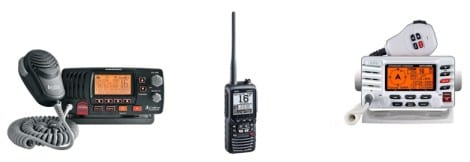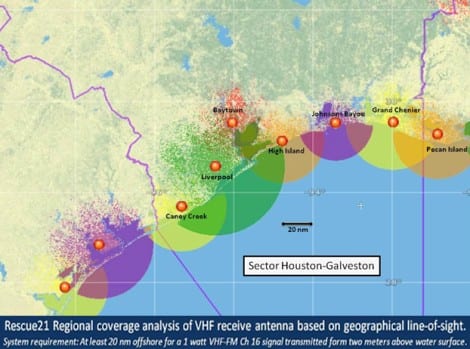Recreational Boating Safety – Digital Selective Calling and the Rescue 21 System
 By Bob Currie, Vessel Examiner
By Bob Currie, Vessel Examiner
United States Coast Guard Auxiliary Flotilla 081-06-08
We have been discussing how to avoid accidents at sea. This column is devoted to using your marine radio when an emergency develops. It is important to have a marine radio that has the Digital Selective Calling system, or DSC. A DSC/VHF radio, when combined with the Coast Guard’s Rescue 21 initiative, can be a great advantage for boaters.
Flotilla 081-06-08 is based at Coast Guard Station Galveston. The Coast Guard Auxiliary is the uniformed civilian component of the US Coast Guard and supports the Coast Guard in nearly all mission areas. The Auxiliary was created by Congress in 1939. For more information, please visit www.cgaux.org.
For starters, it can greatly reduce the time it will take the Coast Guard to find you in case of an emergency. Secondly, in case of emergency, your radio will tell the Coast Guard vital information about you: information like the name and description of your boat, exactly where you are located, even who to contact in case of emergency. The system is automatic; it will continue to transmit information even if you can’t man your radio. Finally, it’s simple to use. Even guests on your boat can make this easy call for help in a crisis.

How Digital Selective Calling Works
Not all DSC capable radios are the same. The simplest type is a Class D with DSC but no GPS, such as the black radio on the left. When the red distress button is pressed, the radio transmits a pre-programmed message to the Coast Guard as well as all boats within range of the signal. It does not, however, transmit GPS coordinates unless it is connected to your onboard GPS. The radio in the middle is DSC capable and has built-in GPS, so in addition to transmitting the distress signal it also transmits your GPS coordinates. The radio on the right is both DSC capable with built-in GPS, so it also transmits coordinates without having to be connected to an external GPS. The Coast Guard Rescue 21 System is a system of strategically placed radio towers that triangulates your position. Even if you do not have your radio linked to your GPS, the Coast Guard can locate your position.
Once you press the red distress button, your radio sends a digital signal over Channel 70. That signal goes to the Coast Guard, but it also goes out to all boats within range that have DSC/VHF radios. The radio will continue to send the message until someone acknowledges it. This message is fast (only 1/3 of a second), accurate, complete and automatic. It will continue to broadcast even if the skipper is incapacitated.
Your distress signal alerts the Coast Guard Watchstander that you have a boating emergency. The digital information that is transmitted when you push the red distress button tells the Coast Guard the exact location of your boat (latitude and longitude) as well personal information and a description of your boat. The Watchstander will acknowledge your message, and your radio will automatically switch to Channel 16 so you can talk directly to the Coast Guard. In addition, other nearby vessels will be notified where you are and that you are in a crisis.
Putting It All Together
Statistics show that only about 10% of the owners of a DSC radio have programmed their radios to be able to use this lifesaving feature. In order to take advantage of your DSC/VHF radio, you will need 5 things.
1. A DSC/VHF radio
2. An MMSI (Maritime Mobile Service Identity) Number
3. A GPS (internal to the radio or externally connected to a GPS)
4. A Two wire connection to your GPS (NMEA In and Out) if needed
5. Knowledge of your DSC radio
GPS Receiver
To ensure a GPS is compatible with the DSC/VHF radio you’ll need to verify that the GPS supports NMEA. If you don’t see this information on the packaging, you can look in the user manual under specifications. The specifications should say NMEA 0183 Input and NMEA output or they may say “supports DSC.” This means it displays position data from a DSC-capable VHF radio. Once you’ve properly installed your DSC/VHF radio and your GPS, you will need to make the connection from the radio to the GPS. There will be wires labeled “NMEA Device In” and “NMEA Device Out.” Connect the “NMEA in” on the radio to the “NMEA out” on the GPS. Then connect the “NMEA out” from the radio to the “NMEA in” on the GPS. Some systems may also require you to connect a ground wire between the two systems. In addition, you may need to configure your GPS to communicate with your DSC/VHF radio. You can do this by changing the communication settings in the GPS. Refer to your manual for details.
MMSI Number
The Marine Mobile Service Identity (MMSI) number is the most important step in making sure your radio and GPS will work with the Rescue 21 program. Please note that your DSC radio will not work correctly without an MMSI number. You can get an MMSI number by going to http://www.boatus.com/mmsi/. This service is free and it only takes a few minutes. Your MMSI number will be a nine digit number that contains your boat and emergency contact information. You can also use your MMSI number to hail other vessels, and other vessels can use it to contact you. Think of it as a phone number for your DSC/VHF radio. But its most important feature is to send information about your boat to the Coast Guard when someone activates the red distress button. Once you get an MMSI number, you’ll need to program it into your DSC/VHF radio.
Testing the System
Once your MMSI number is programmed into the radio and the radio and the GPS are linked, you will be able to see the MMSI number displayed on the radio display and you will be able to see your Lat/Long position displayed on your radio as well.
Here it gets a little bit tricky. You can’t just press the distress button to test it. You’ll need to get the MMSI number for either a friend’s radio or a shore station. Enter that number into your radio. Choose a working channel, but NOT channel 16. Select Routine Call from your radio. Now press either enter or send. Your radio should indicate the call was sent and indicate that whomever you called received your call. Finally, it will switch to the working channel you chose. You can now communicate with the other station to ensure that everything is working properly.
Rescue 21 System
The closest Rescue 21 radio towers for our area are located at High Island, Baytown, and Liverpool. If you will look at the map you will see overlapping coverage, which is necessary for determining a precise location using radio triangulation. In areas where there is no overlapping coverage, the system will provide a single line that can be used to search for a vessel that has sent out a distress signal or otherwise transmitted a distress signal by VHF radio, such as with older marine radios that are not DSC capable.

Another feature of the Rescue 21 system is that radio transmissions are recorded and those recordings can be searched and reviewed. If the system receives a transmission, then that single transmission is all that is needed to locate the sender.
Note: The Rescue 21 system was used recently to locate and save four fishermen from a sinking vessel 30 miles offshore from Galveston.
For more information on boating safety, please visit the Official Website of the U.S. Coast Guard’s Boating Safety Division at www.uscgboating.org. Questions about the US Coast Guard Auxiliary or our free Vessel Safety Check program may be directed to me at [email protected]. I am available to perform free Vessel Safety Checks, and I will come to your location to perform them. SAFE BOATING!
[3-20-2018]

 Posted in
Posted in 























